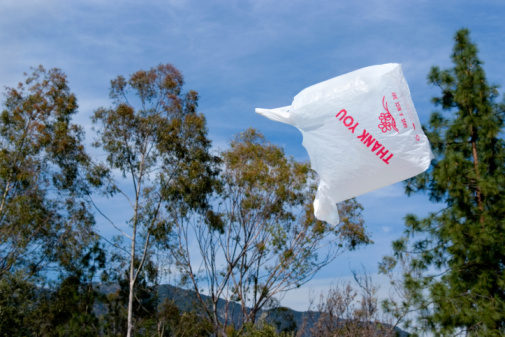![]()
Most Americans do their shopping once a week, a frantic day filled with yellow plastic bags. Whether your shopping list gets stuck to a slab of steak or you drop the eggs, it’s always a day full of surprises. Fortunately, there are ways to make this a better experience for both you and the environment; one of these ways is reusable bags.
Unfriendly Statistics
Statistics show the age-old question of paper or plastic ends in the same polluted, dysfunctional world.
Over the years, researchers pitted plastic against paper, but the new obsession with a green earth has uncovered that these two nemeses are actually on the same team. The U.S. National Oceanic and Atmospheric Association states that plastic is the largest source of ocean litter, killing at least one million sea birds and 100,000 mammals each year (1). Approximately 500 billion to one trillion plastic bags are used worldwide every year, with an average person using 380–500 a year (1). Some 12 million barrels of oil are required to make that number of plastic bags (2). This may make you lean toward using paper bags, but wait, there’s more.
The paper bag statistics are just as depressing, with one source stating that in 1999, 14 million trees were used to make 10 billion paper grocery bags for Americans (1). Most grocery bags are made of kraft paper, which is created through heating wood chips at high temperatures in a chemical solution. This process is dangerous to our environment, causing acid rain and water pollution. Millions of gallons of these chemicals go into waterways each year, and the long-term effects work through the food chain. To top it off, neither paper nor plastic is degradable, since the lack of oxygen, water and sunlight in modern landfills prevents anything from fully breaking down (3).
The Battle Continues
So, what makes reusable bags better? For one, they are made from eco-friendly sources, including hemp, jute and even recycled plastic bottles. The canvas bag is the most popular according to Treehugger.com, often made from either organic cotton or hemp. Then, there are polyester tote bags, which at 35 grams only create 89 grams of greenhouse gas emissions. This compares to the manufacturing of seven disposable plastic shopping bags (4).
The next types are polypropylene bags, usually designed in the shape of a brown paper bag. These seem to be the most popular at the checkout lines of many grocery stores. At 103 grams, the manufacturing of each bag creates 138 grams of greenhouse gas emissions. This compares to the manufacturing of 11 disposable plastic shopping bags. (4)
The reusable bags have their problems as well, but they are a better fix than their eco-destroying contemporaries. Even though many people double bag their vegetables and meat, many of these bags can harbor dangerous bacteria like salmonella and E. coli. To prevent this, designate certain bags for products like meat and poultry that can contain bacteria. Also, remember to wash those bags at least once a week; follow the manufacturers’ instructions, but many bags can be thrown in the washing machine (5). Do the drying process old-school by hanging it outside, since natural sunlight provides enough heat to kill bacteria.
Once you go the reusable route, what will happen to all those little plastic critters seeking shelter at the bottom of your pantry and closet? If you have a pet, you now have an endless supply of pooper scoopers, and they also make a great lining to waste baskets in various rooms in the house or apartment. If you must dispose of them, tie bags in a knot so they won’t become windblown litter.
It Ain’t Easy Being Green
Most people new to the whole green idea tend to be scared off when they see the prices of some reusable bags. The average price is $5–12 dollars a bag, according to various online retailers, depending on how fashion forward they are. These prices can add up, especially if people use around 10 bags each time they shop. Many shoppers are avoiding this price tag by purchasing the bags provided by the supermarkets themselves, many of them only a dollar apiece. Though this seems like a temporary steal, they often only last a couple months, compared to the pricier bags’ lifespan averaging several years.
Like many other green efforts, adopting reusable bags starts as an individual goal, and shoppers must have the incentive to change their ways in order for global change to take place. Many shoppers are guilty of driving halfway to the store before realizing their eco-friendly friends were left hanging on a coat hanger in the basement. Try keeping them in the car at all times, just in case you tend to be scatterbrained. Also remember to actually bring the bags in the store with you, since the easiest thing to do is just grab the plastic ones if you happen to be parked far away. Try putting a reminder for yourself on your key chain, like tying a ribbon on it. With a little push, we can all start saving the environment, one plain or trendy tote bag at a time. WF
References
1. ReuseThisBag.com, “Why Use Reusable Shopping Bags?” www.reusethisbag.com/why.asp, accessed Feb. 8,2012.
2. Forest Ecology Network, “Paper or Plastic? Neither!” www.forestecologynetwork.org/climate_change/plastic_or_paper.html, accessed Feb. 8, 2012.
3. ProjectGreenBag, “Paper Bags Are No Better Than Plastic,” www.projectgreenbag.com/paper-bag-are-no-better-than-plastic/, accessed Feb. 8, 2012.
4. Treehugger, “Reusable Shopping Bags: Which is the Greenest of Them All?” www.treehugger.com/clean-technology/reusable-shopping-bags-which-is-the-greenest-of-them-all.html, accessed Feb. 8, 2012.
5. TLC, “How to Keep Your Reusable Bags Clean and Safe,” http://tlc.howstuffworks.com/home/reusable-bag-clean.htm, accessed Feb. 8, 2012.
Published in WholeFoods Magazine, April 2012










